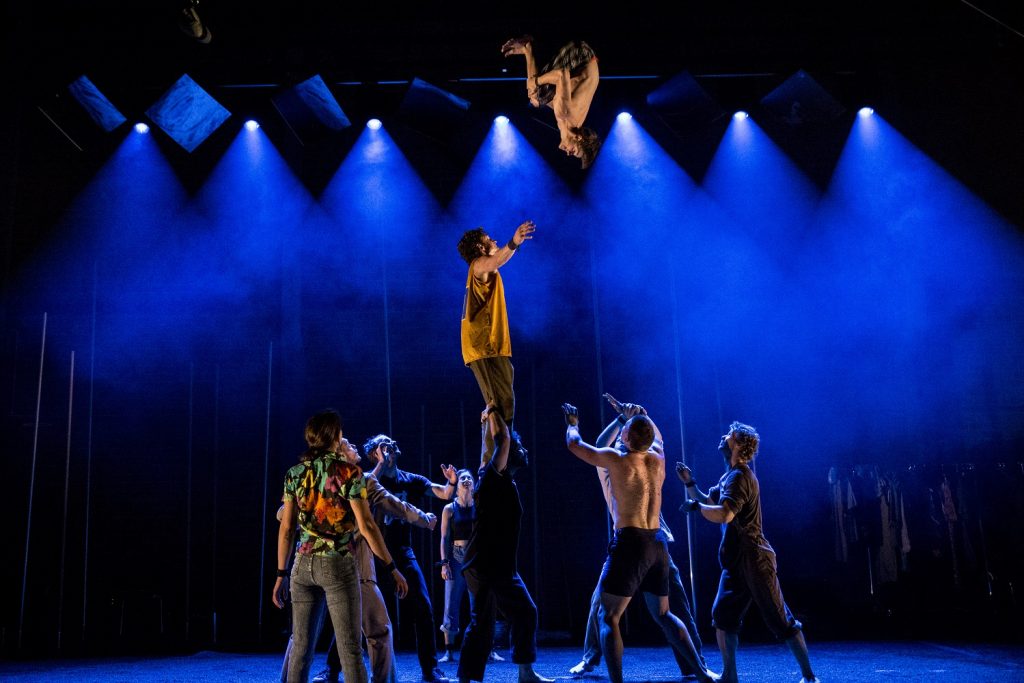As the curtain rose on Gravity & Other Myths’ “Backbone” at The Broad Stage this weekend, the house lights didn’t go down—surprising at first, and whispers circulated the audience. But as the cast of acrobats took their places, it became clear that they were setting for a warm-up, rather than launching into their staged performance. These first few moments prepared us for the scene ahead: a crew of talented acrobats in an ever-fluid state of play. They called out cues, vocalizing “ready,” “up!” and “coming in!”
The transparency was such a departure from circus spectacle, opening the artists’ process to the audience and allowing the notion that, yes, what these people do is incredibly difficult. With effort unveiled, acrobats Lachlan Binns, Jascha Boyce, Martin Schreiber, Jacob Randell, Joanne Curry, Lachlan Harper, Mieke Lizotte, Jackson Manson, Lewis Rankin, and Lewie West became human rather than creature.
“We won’t be transporting you to Verona,” the program notes read. “We are on a stage. In a theater. In front of you.”
And at that, they were off. Costume changes into everyday clothing reinforced their humanity; no gimmicks there. Gasp-worthy displays of agility were put into a new light as the artists continued to call cues. Human towers almost 20 feet tall, twisting flips and fearless dives held attention at a high point throughout the evening. In this new perspective, each feat becomes both more awe-inspiring and more terrifying. Catapulting a spiraling human over another’s head is riskier than catapulting a character. The company’s deliberate focus on human connection is not to be taken lightly; these tasks require attention to every breath, every being, every particle in the space.
Composer-musician Elliot Zoerner on percussion and musician Shenton Gregory on violin painted a live score to which the acrobats could sync with each other. Somehow both ambient and dynamic, their accompaniment presented its own virtuosity but never pulled attention from the acrobats. Stage and lighting design by Geoff Cobham jogged memories of STOMP, for some reason, the larger-than-life rods stretching to match the height of the stacked acrobats. Dark tones with soft spotlights directed attention appropriately, flattering the movement but allowing the acrobats enough light to see for tricky throws and catches.
And then there was the overwhelming presence of strength. A performance titled “Backbone” would, of course, imply such a presence. But this was unprecedented. In one segment, Boyce carried a weighted rock while balancing and even spinning on the cast’s backs, heads, hands, feet—you name it—all while maintaining eye contact with a single audience member. Lizotte balanced her sacrum on a single pole hoisted in the air by her colleagues. Harper executed countless consecutive standing corkscrews. Each display of strength, it seemed to me, was made exponentially stronger by an element of calibration. Expertly balanced and extremely aware of their kinetic placement, the artists coaxed physics—and gravity, pun intended—into the palms of their hands.
Perhaps most respectable was that the cast maintained a playful sense of experimentation throughout. It was evident that some tasks were still challenging, that they would need to adjust and adapt. Yet they remained energetic even while focused, and clearly enjoyed the evening all the way through—smiles and laughs were abundant onstage and contagious in the audience.
Director Darcy Grant’s “Backbone” was no elaborate cirque, no campy space exploration. The artists simply allowed us into their research lab, for a look into their extraordinary work and inimitable strength.
Written by Celine Kiner for LA Dance Chronicle, October 30, 2019
To visit the Gravity & Other Myths website, click here.
Featured image: Gravity and Other Myths – “Backbone” – Photo by Hamish McCormick










